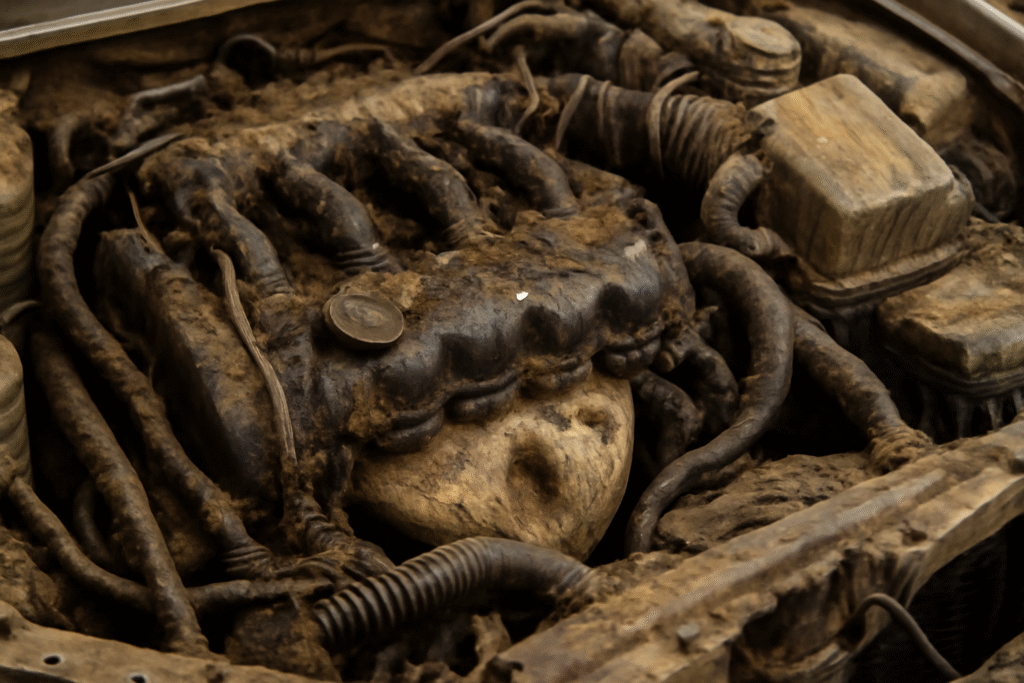
How to Perform an Engine Flush: A Step-by-Step Guide for Optimal Engine Performance
Is your car feeling sluggish, or does it seem like the engine isn’t running as smoothly as it should? 
In this guide, we’ll walk you through the process step-by-step, making it easy to follow and implement. Whether you’re a beginner or just looking to save on costly mechanic bills, knowing how to flush your engine properly can lead to better performance and longer engine life. Keep reading to discover everything you need to know for optimal engine care and how a clean engine can boost your car’s performance. Let’s get started!What is an Engine Flush?
An engine flush is a cleaning process that helps remove sludge, carbon deposits, and other harmful contaminants from your engine’s internal components. Over time, the engine oil in your vehicle can break down, causing these particles to accumulate. This buildup can affect your car’s performance, fuel efficiency, and even cause long-term damage.
The engine flush process involves adding a specially formulated cleaning agent to the engine oil, running the engine for a short period, and then draining the oil. This cleaning solution helps to break down and loosen the deposits, which are then flushed out when the oil is drained. After the flush, new oil is added to the engine to ensure smooth operation.
Performing an engine flush is an effective way to keep your engine running at its best, preventing costly repairs down the road. Regularly flushing your engine can also improve fuel efficiency and extend the overall lifespan of your vehicle.
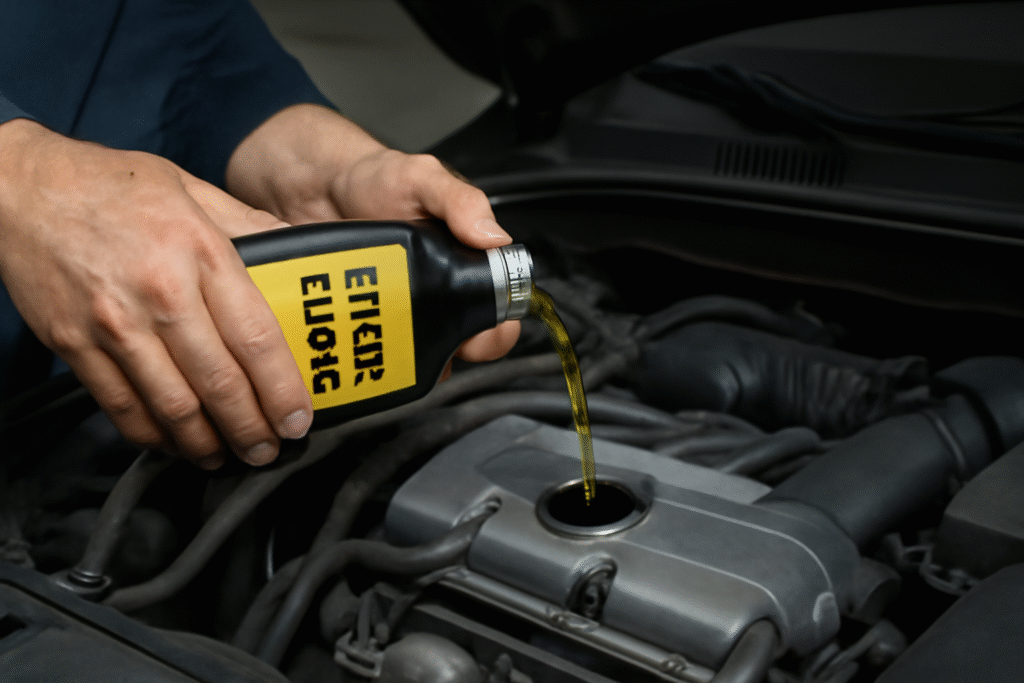
Table of Contents
ToggleSigns That Your Engine Needs a Flush
How do you know when it’s time to perform an engine flush? Keep an eye out for these telltale signs that your engine could use a cleaning boost:
1. Sluggish Engine Performance
If your engine feels sluggish, especially during acceleration, it could be a sign of built-up sludge and contaminants. These deposits restrict the flow of oil, which in turn affects engine performance. An engine flush can clear the gunk and restore smooth operation.
2. Decreased Fuel Efficiency
Noticing your gas mileage is slipping? Poor fuel efficiency can be caused by dirt and debris clogging engine parts. When oil can’t circulate freely, your engine has to work harder, using more fuel. A flush helps remove these obstructions, allowing the oil to flow smoothly and boosting fuel economy.
3. Unusual Engine Noises
A healthy engine runs quietly, but if you hear knocking, tapping, or other odd sounds, it could indicate that the engine oil is thick or contaminated. These sounds often happen when the oil fails to lubricate properly due to sludge buildup. Flushing the engine can get rid of these contaminants and reduce noise.
4. Warning Lights on the Dashboard
When your check engine or oil pressure light comes on, it’s a signal that something’s wrong. While this could point to a variety of issues, a clogged engine can be the culprit. If you’re experiencing any of the above signs along with a warning light, an engine flush might be exactly what you need to solve the issue.
5. Poor Oil Pressure
If your engine oil pressure is low or fluctuating, it could be due to thickened or contaminated oil. A flush can help restore proper oil flow and maintain consistent oil pressure, ensuring your engine runs efficiently and smoothly.

Benefits of Performing an Engine Flush
An engine flush offers several key benefits that contribute to the overall health and performance of your vehicle. Here’s why you should consider it:
1. Improved Engine Performance
Over time, sludge and debris can accumulate in your engine, causing it to perform poorly. By flushing out these contaminants, the engine oil can circulate freely, leading to smoother engine performance. This means less strain on your engine, better acceleration, and an overall more responsive driving experience.
2. Enhanced Fuel Efficiency
A clean engine runs more efficiently, which directly impacts fuel consumption. When your engine is clogged with gunk, it has to work harder to function, burning more fuel in the process. After an engine flush, your vehicle’s fuel efficiency can improve as the engine operates more smoothly and uses less fuel to achieve the same results.
3. Prolonged Engine Life
Regular engine flushing can help extend the life of your engine by preventing harmful buildup that causes wear and tear. By clearing out sludge and carbon deposits, you reduce the risk of long-term engine damage, saving you from costly repairs and early engine replacement.
4. Prevents Costly Repairs
A buildup of sludge can lead to blocked oil passages, overheating, and even complete engine failure. An engine flush is a simple, cost-effective way to prevent these issues. By keeping your engine clean, you’ll avoid major repair bills and keep your vehicle running at its best for years to come.
5. Better Oil Flow and Lubrication
When your engine oil becomes thick or contaminated, it can’t lubricate your engine properly. An engine flush helps restore the oil’s viscosity, allowing it to flow freely and provide the necessary lubrication to prevent excessive friction and overheating.
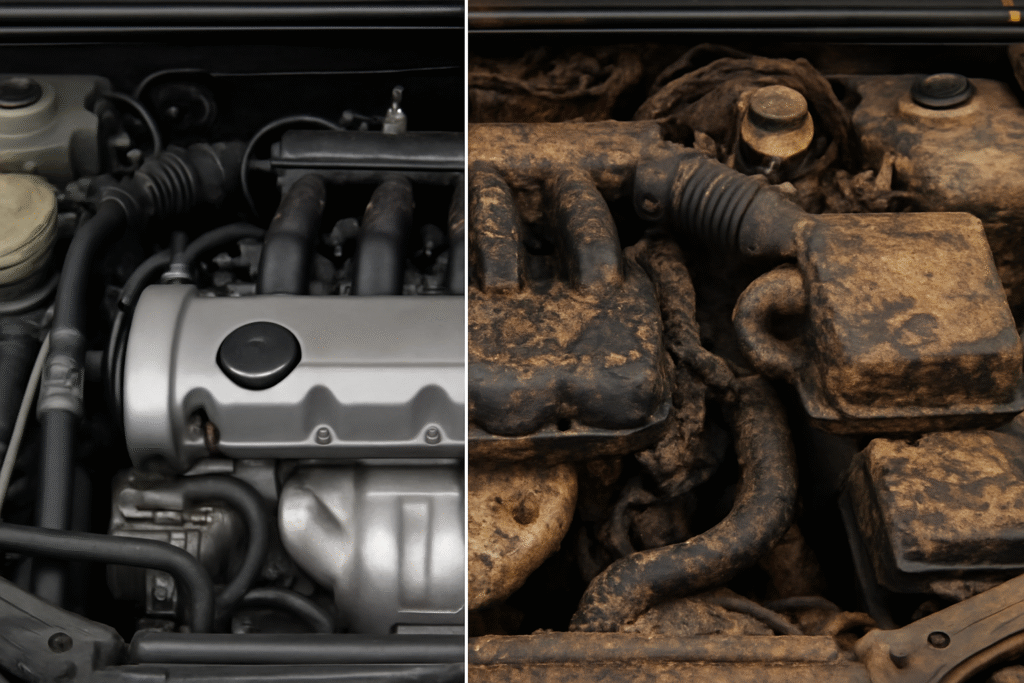
Tools and Materials Needed
Before you perform an engine flush, it’s important to have the right tools and materials on hand. Here’s a quick list of what you’ll need to ensure a smooth and effective engine cleaning process:
1. Engine Flush Solution
This is the key ingredient for the engine flush. It’s a specially formulated liquid designed to break down and remove sludge and contaminants in the engine. You can find engine flush solutions at most auto parts stores or online. Be sure to choose one that’s compatible with your vehicle’s engine.
2. New Engine Oil
After you drain the old, contaminated oil, you’ll need fresh, clean engine oil to replace it. Make sure the oil you use matches the specifications listed in your car’s manual for optimal performance. Choose a high-quality brand that suits your vehicle’s engine type.
3. Oil Filter
Replacing the oil filter is crucial after an engine flush. This ensures that no leftover debris or sludge remains in your engine. Make sure to choose the right filter for your car’s model to ensure proper fit and function.
4. Wrenches and Tools for Oil Drain Plug
You’ll need a wrench or socket set to remove the oil drain plug and oil filter. Make sure you have the correct size tools to avoid damaging the plug or filter.
5. Drain Pan
To catch the old oil and flush solution, place a drain pan underneath the engine. A large, sturdy pan will prevent spills and keep your workspace clean.
6. Funnel
A funnel is essential for adding new oil without making a mess. It will help guide the oil into the engine smoothly and prevent spills.
7. Rubber Gloves
Engine oil can be messy, so protect your hands with a pair of rubber gloves. This will also help keep you safe from any potential chemicals in the engine flush solution.
8. Rags or Towels
Keep some rags or towels on hand to clean up any spills or drips. They’re also useful for wiping down tools and parts during the process.
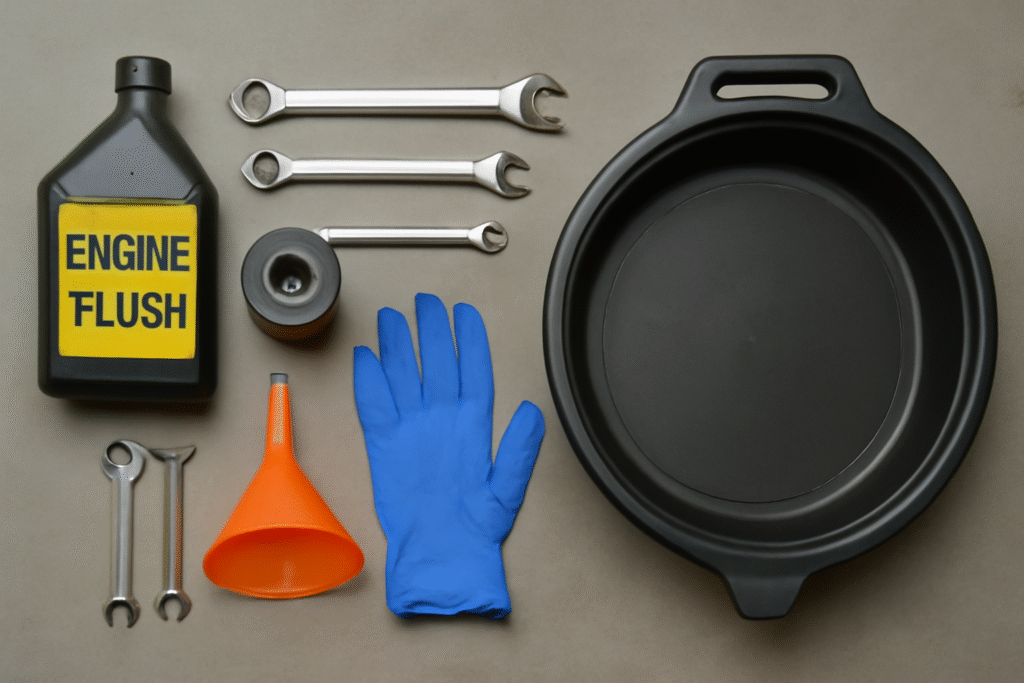
Step-by-Step Guide: How to Perform an Engine Flush
Performing an engine flush is a straightforward process, but it’s important to follow each step carefully to ensure the best results. Here’s your step-by-step guide to performing an engine flush like a pro:
Step 1: Prepare Your Vehicle
- Park on a level surface: Ensure your car is parked on a flat, stable surface to avoid any accidents while draining the oil.
- Let the engine cool down: Make sure the engine is cool to the touch. Hot engines can cause burns or damage during the process.
- Gather your tools: Have everything you need within reach — from the engine flush solution to the oil filter and new oil.
Step 2: Add the Engine Flush Solution
- Locate the oil reservoir: Open the hood and find the oil filler cap. This is where you’ll add the engine flush solution.
- Add the solution: Pour the recommended amount of engine flush solution into the oil reservoir. Follow the instructions on the product’s label for the exact quantity.
- Start the engine: Start your car and let the engine idle for about 5-10 minutes. This allows the flush solution to circulate and break down the contaminants inside the engine.
Step 3: Drain the Oil
- Turn off the engine: After the flush solution has circulated, turn off the engine and let it sit for a few minutes to cool slightly.
- Place the drain pan: Put a drain pan under the oil drain plug to catch the old oil and flush solution.
- Remove the oil drain plug: Using a wrench, carefully remove the oil drain plug and allow the old oil and flush solution to drain completely. Be cautious, as the fluid may still be hot.
Step 4: Replace the Oil Filter
- Remove the old filter: Use an oil filter wrench to remove the old oil filter. Be sure to dispose of it properly.
- Install the new filter: Lubricate the rubber seal of the new filter with a small amount of fresh oil, then screw it on tightly, making sure it’s secure but not over-tightened.
Step 5: Add Fresh Oil
- Add new oil: Use a funnel to pour the recommended amount of fresh oil into the engine. Check your car’s manual for the correct oil type and quantity.
- Check oil level: After adding the oil, use the dipstick to check the oil level and top it up if necessary.
Step 6: Dispose of the Old Oil Properly
- Proper disposal: Don’t throw away the old oil. Take it to an auto shop or recycling center that accepts used engine oil and oil filters. Many places will dispose of it for you free of charge.
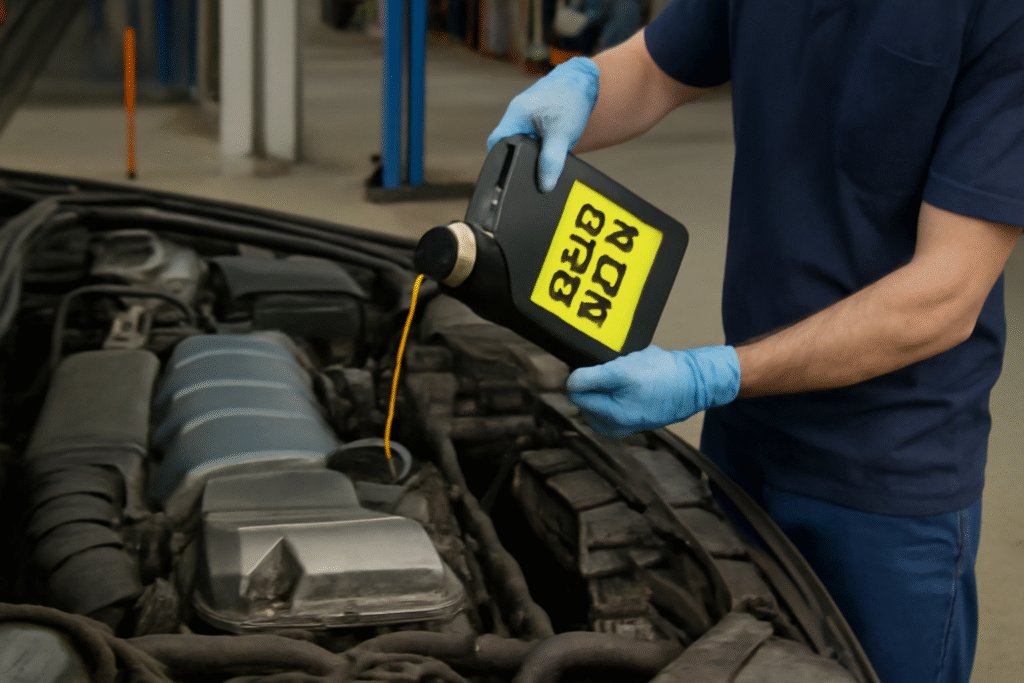
Common Mistakes to Avoid During an Engine Flush
Performing an engine flush can be simple, but there are a few mistakes that can undermine its effectiveness. Here are the most common pitfalls to avoid:
1. Not Following the Product Instructions
Each engine flush solution is different, so it’s essential to follow the manufacturer’s instructions carefully. Using too much or too little of the flush solution can either fail to clean the engine properly or cause potential damage. Always check the recommended quantity and instructions on the product label.
2. Skipping the Oil Filter Replacement
When you perform an engine flush, it’s critical to replace the oil filter afterward. If you skip this step, any debris or sludge that was in the old filter will re-enter your engine, undoing all the cleaning you just did. A new filter ensures your engine stays clean and well-maintained.
3. Using the Wrong Oil Type After Flushing
After completing the engine flush, always add the correct oil type for your vehicle. Using the wrong viscosity or grade of oil can negatively affect engine performance and lead to premature wear. Always refer to your car’s manual for the specific oil recommendations.
4. Overusing the Flush Solution
More isn’t always better. Overusing engine flush solution can cause damage to engine seals or gaskets. Stick to the recommended amount based on your vehicle’s specifications to avoid complications.
5. Not Letting the Engine Cool
Before draining the oil, make sure your engine has cooled down sufficiently. Draining hot oil can be dangerous and messy, and it may also cause burns. Allow the engine to cool for a few minutes after turning it off to ensure safe handling.
6. Ignoring Proper Disposal of Old Oil
Never dispose of old oil improperly. Used oil can be harmful to the environment, so always take it to a recycling center or an auto shop that accepts it. Proper disposal helps protect our planet and ensures you’re following local regulations.
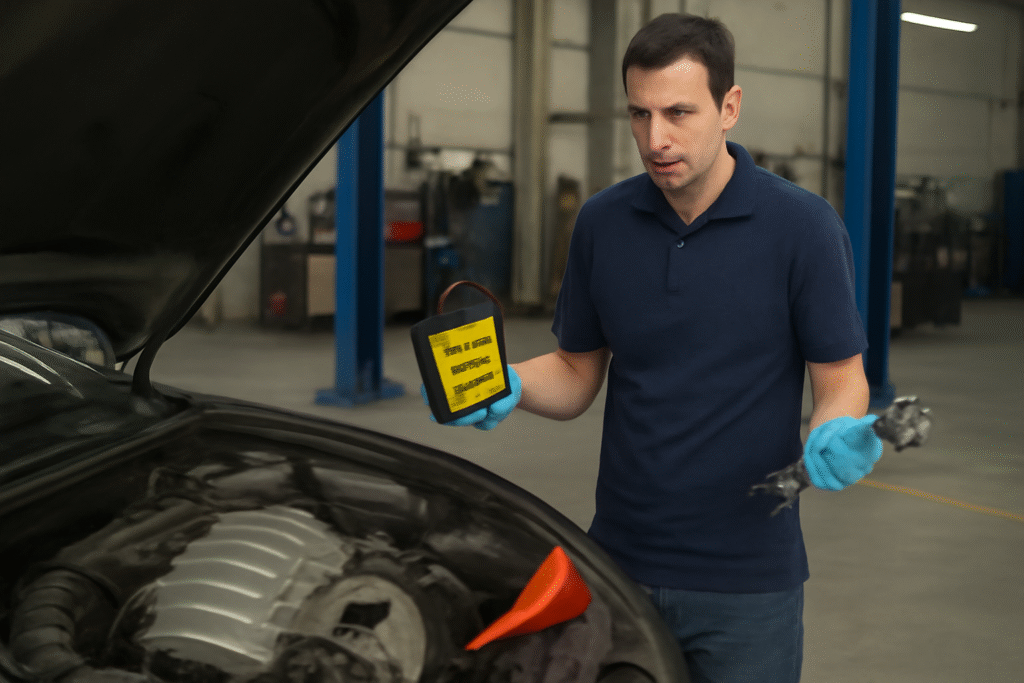
When Should You Perform an Engine Flush?
Knowing the right time to perform an engine flush can help you avoid major engine problems and maintain your vehicle’s performance. Here’s when it’s time to give your engine a thorough clean:
1. Regular Maintenance (Every 30,000-50,000 Miles)
For most vehicles, an engine flush is recommended every 30,000 to 50,000 miles. Regularly flushing your engine at these intervals helps keep contaminants from building up and ensures your engine stays in good condition. Check your car’s manual for manufacturer recommendations specific to your vehicle.
2. After Purchasing a Used Car
If you’ve recently bought a used car, performing an engine flush is a smart move. Older vehicles often have a buildup of sludge and deposits in the engine, especially if maintenance has been neglected. An engine flush will help clear out any contaminants and restore engine performance.
3. When You Notice Performance Issues
If your engine starts feeling sluggish, makes unusual noises, or if the fuel efficiency drops suddenly, it could be time for an engine flush. These are signs that your engine may be clogged with debris, and a flush can help restore its performance. If you notice the check engine light or oil pressure warning light on, an engine flush might be just what you need.
4. After an Oil Change With Low-Quality Oil
If you’ve used low-quality or improper oil in the past, sludge may have built up in your engine. Performing an engine flush after switching to high-quality oil can help clear out any accumulated contaminants and improve engine performance.
5. When Changing Oil Types or Upgrading to Synthetic Oil
If you’re upgrading to synthetic oil or switching oil types, it’s a good idea to perform an engine flush. Synthetic oils tend to be thinner and more effective at cleaning out engine debris. Flushing the engine first ensures that your new oil can work efficiently.
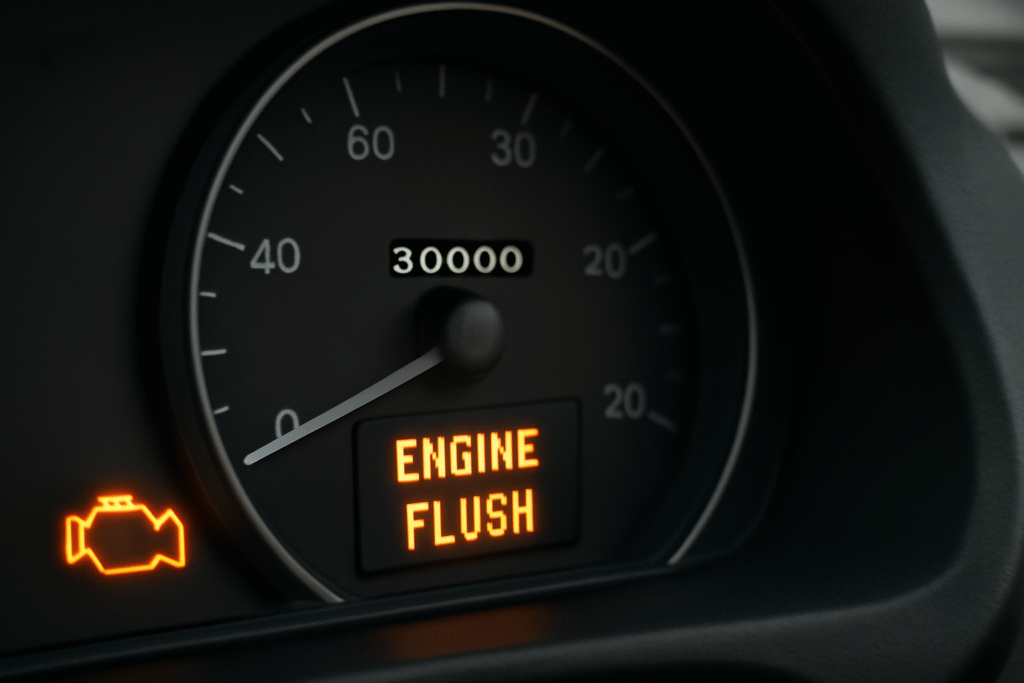
Engine Flush Alternatives
While an engine flush can be incredibly effective, there are alternative methods to help clean your engine and maintain its performance. Here are some options to consider:
1. Professional Engine Cleaning Services
If you’re not comfortable performing an engine flush yourself, many auto repair shops offer professional engine cleaning services. These services use specialized tools and solutions to clean the engine, ensuring all contaminants are removed. It’s a great option if you’re unsure about the process or lack the time to do it yourself.
2. Oil Additives
Oil additives are a more subtle alternative to an engine flush. These additives are poured into your oil reservoir before an oil change. They help break down sludge and contaminants, allowing them to be removed during the next oil change. While not as powerful as a full engine flush, oil additives can be a good option for cars with minor buildup.
3. DIY Cleaning With Engine Oil
Another alternative to a full engine flush is to perform a DIY cleaning by changing the engine oil more frequently. By draining the oil and replacing it regularly with high-quality oil, you can help prevent the accumulation of sludge and debris in the engine. This method is more gradual but can still be effective for maintaining engine cleanliness over time.
4. Engine Flush Through the Oil Change
Some vehicle owners choose to combine their engine flush with an oil change, especially if the engine is relatively clean. Instead of using a separate flush solution, you can try a more thorough oil change process by running the engine for a few minutes after adding new oil to help break down any minor contaminants. This can provide a lighter cleanse than a full flush but still help improve engine performance.
5. Using Synthetic Oil
Switching to synthetic oil can be an effective way to prevent sludge buildup and improve overall engine cleanliness. Synthetic oils have superior cleaning properties compared to conventional oils, which can help minimize the need for an engine flush. However, this option works best as a preventative measure rather than a solution for an already dirty engine.
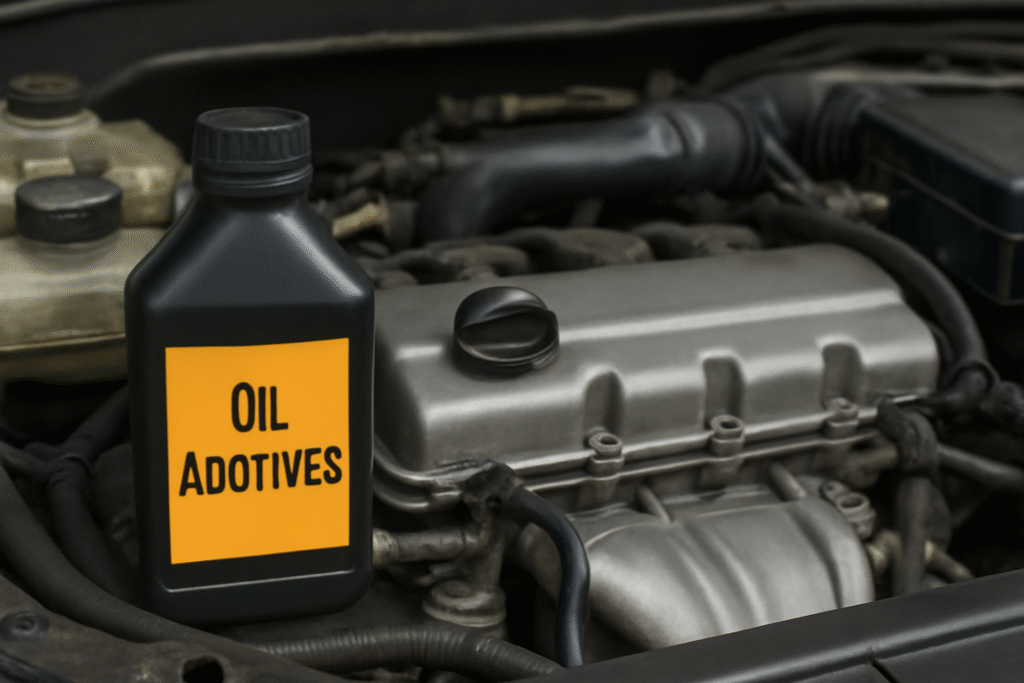
Performing an engine flush is a simple yet highly effective way to maintain your vehicle’s engine performance and extend its lifespan. By removing sludge, contaminants, and carbon deposits, an engine flush helps ensure smoother operation, improved fuel efficiency, and reduced wear and tear on your engine. Whether you’re tackling it yourself or seeking professional help, regular engine flushing is a smart investment in your car’s longevity.
Remember to perform an engine flush at the recommended intervals, keep an eye out for signs that your engine needs a clean, and follow the proper steps to get the best results. If a full engine flush isn’t for you, there are plenty of alternatives like oil additives or professional cleaning services that can provide similar benefits.
By staying on top of engine maintenance, you’re ensuring a smoother, more efficient ride for years to come. 

Frequently Asked Questions (FAQ)
1. What is an engine flush, and why is it necessary?
An engine flush is a process of cleaning your car’s engine by removing sludge, carbon deposits, and other contaminants from the oil and engine components. It’s necessary because over time, engine oil breaks down, leading to buildup that can reduce performance, cause engine strain, and even result in costly repairs. Regular flushing helps maintain engine health and efficiency.
2. How often should I perform an engine flush?
Most vehicles benefit from an engine flush every 30,000 to 50,000 miles. However, if you notice signs of engine strain like decreased fuel efficiency or unusual noises, you may need to flush the engine sooner. Always refer to your car’s manual or consult a mechanic for personalized recommendations.
3. Can I perform an engine flush myself?
Yes, you can perform an engine flush yourself if you have the right tools and follow the proper steps. You’ll need an engine flush solution, new oil, an oil filter, and some basic tools. Just make sure to follow the instructions carefully to avoid any mistakes that could harm your engine.
4. What are the signs that my engine needs a flush?
Signs that your engine needs a flush include sluggish engine performance, decreased fuel efficiency, unusual engine noises, warning lights on the dashboard (such as the check engine light), or poor oil pressure. If you notice any of these, an engine flush can help restore performance.
5. Can an engine flush damage my car?
When done correctly, an engine flush won’t damage your car. However, using the wrong products or overusing the flush solution can cause damage to engine seals or gaskets. It’s important to follow the manufacturer’s instructions and only use products designed for your vehicle.
6. What is the difference between an engine flush and an oil change?
An engine flush is a cleaning process that removes contaminants from the engine before an oil change. While an oil change involves draining the old oil and replacing it with fresh oil, an engine flush uses a cleaning solution to break down and remove sludge and buildup in the engine, ensuring a cleaner, smoother performance.
7. How long does it take to perform an engine flush?
An engine flush usually takes about 30 minutes to 1 hour. This includes adding the flush solution, letting the engine idle to circulate it, draining the old oil, replacing the oil filter, and adding fresh oil. Make sure to also account for cooling time to avoid working with hot engine parts.
8. Is an engine flush necessary for all vehicles?
Not all vehicles need an engine flush. Modern cars with synthetic oils may not require regular flushing, as these oils are designed to minimize sludge buildup. However, older vehicles or those with poor maintenance history may benefit more from an engine flush to remove accumulated contaminants and restore performance.


























